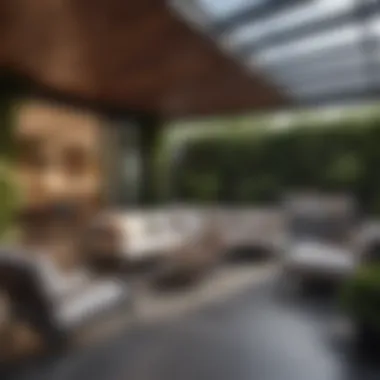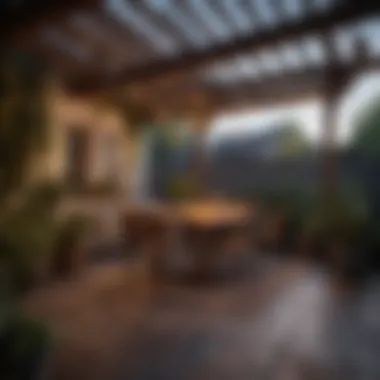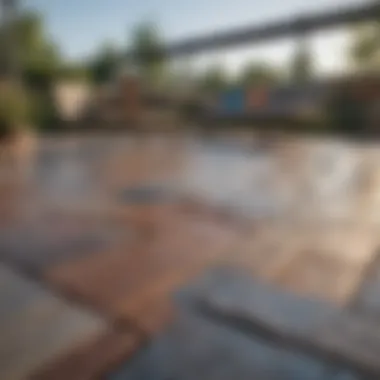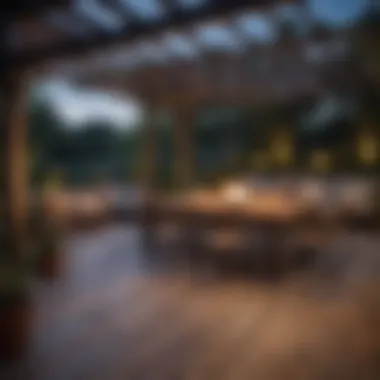Benefits and Design Tips for Outdoor Roofed Patios


Intro
Creating a functional outdoor space is an intelligent decision for homeowners. An outdoor roofed patio offers an exceptional blend of style and practicality. It provides a versatile environment for entertaining guests or enjoying quiet evenings alone. This guide seeks to unpack the various benefits and design considerations associated with outdoor roofed patios, ensuring that homeowners can make informed decisions.
From aesthetics to utility, the advantages are numerous. They protect against weather conditions, allowing outdoor spaces to be enjoyed year-round. Additionally, they contribute to the overall value of a home. This article explores key design inspirations, from trending styles to color palettes, followed by practical tips for maintenance and budgeting. Each aspect will help homeowners create a welcoming outdoor environment, seamlessly blending with their tastes and preferences.
Understanding these factors is not just beneficial; it is essential for maximizing outdoor living potential.
Foreword to Outdoor Roofed Patios
Outdoor roofed patios are increasingly valued by homeowners who seek to expand their living spaces beyond the confines of their homes. They provide versatile areas for relaxation, entertainment, and family gatherings while offering protection from the elements. This section will explore the significance of outdoor roofed patios, their defining features, and their historical evolution, presenting a well-rounded understanding of why these structures are beneficial in contemporary home design.
Definition and Features
An outdoor roofed patio is essentially a covered outdoor area designed for various activities. It offers a sheltered environment without the barriers typically associated with indoor spaces. Key features often include:
- Roofing: This can range from solid structures to expandable awnings, providing varying levels of protection against rain and sun.
- Flooring Options: Choices may include wood, tile, or brick, which offer comfort and aesthetic appeal.
- Furniture and Decor: The selection can vary widely, from dining sets to lounge chairs, tailored to the homeowner's style.
Moreover, incorporating enhanced features such as built-in lighting and heating solutions can further add to the functionality and comfort of these patios.
Historical Context
The concept of outdoor living spaces is not new; various cultures have embraced al fresco dining and leisure for centuries. In warmer climates, ancient architectural designs often featured shaded areas to escape the heat. For instance, Mediterranean villas typically included courtyards that blurred the line between indoor and outdoor spaces.
As Home design practices evolved over time, the significance of outdoor spaces became recognized. In North America, the mid-20th century saw a rise in patio designs as a reaction to suburban living. This trend continues today, with modern materials and designs reflecting both style and practicality, making outdoor roofed patios a staple in contemporary architecture.
"Outdoor Roofed Patios signify not just an extension of living spaces, but a lifestyle choice that prioritizes convenience and enjoyment of nature."
This understanding of outdoor roofed patios provides a baseline from which to evaluate their benefits and design considerations in greater depth.
Key Benefits of Outdoor Roofed Patios
Outdoor roofed patios present numerous advantages for homeowners, making them an attractive addition. Understanding these benefits helps to appreciate their value as part of an outdoor living experience. This section will detail the key benefits of such spaces, focusing on protection from the elements, extended usability, and increased property value.
Protection from Elements
One of the most significant benefits of an outdoor roofed patio is the protection it offers from the harsh elements. Rain, snow, and intense sun can limit outdoor enjoyment. With a roofed patio, you can enjoy the outdoors even during mild inclement weather. The roof acts as a barrier, allowing for outdoor gatherings without concern for sudden downpours or intense heat.
Moreover, shielding from UV rays is vital to safeguarding furniture and fixtures that are often exposed to the elements. Prolonged sun exposure can cause deterioration, leading to higher replacement costs. A roofed patio minimizes this risk and helps extend the life of outdoor furnishings, making it a wise investment.
Extended Usability
Another important aspect is extended usability. Outdoor roofed patios can be used year-round. In colder months, they can be outfitted with heating solutions such as outdoor heaters or fire pits. Likewise, in the warmer seasons, they provide cool shade where one can escape the sun’s intensity.
This versatility allows homeowners to utilize their spaces for various activities all year long. Whether it’s hosting parties, family gatherings, or simply enjoying a peaceful moment, the roofed patio adapts to various needs effortlessly. The ability to transition between different activities enhances the enjoyment of outdoor living spaces.
Increased Property Value
Lastly, an outdoor roofed patio can significantly increase a property’s value. Many prospective buyers see such spaces as desirable additions, often considering them as part of the home’s livable square footage. Buyers appreciate the practical benefits that come with these patios, which often lead to a faster sale or higher offer price.
Real estate experts emphasize the impact of outdoor living spaces in today’s market. They highlight that well-designed patios appeal to a broad audience, making properties stand out. Investing in an outdoor roofed patio not only enhances your immediate living experience but also contributes toward long-term value as the market sees increasing demand for outdoor amenities.
"An outdoor roofed patio is not just a functional space; it is an investment in your home’s appeal and worth."


In summary, the benefits of outdoor roofed patios are substantial. They protect from inclement weather, provide extended usability throughout the seasons, and increase property value. As such, they represent a strategic choice for homeowners looking to improve both their outdoor living experience and property investment.
Design Considerations for Outdoor Roofed Patios
Designing an outdoor roofed patio involves careful consideration of several factors that can influence its functionality and aesthetic appeal. This space is not only an extension of your home but also a venue for relaxation, entertainment, and various outdoor activities. Therefore, the right design choices can significantly enhance its usability and comfort.
Choosing the Right Location
Selecting an appropriate location for your patio is the first step in the design process. The site’s exposure to sunlight, wind, and rain will dictate its comfort level throughout the year. Ideally, consider a spot that receives morning sun and afternoon shade, allowing for a comfortable afternoon gathering. Additionally, proximity to your home is crucial for access to utilities, like electricity and water, which can facilitate various functionalities in your outdoor space. Proximity to indoor areas, like the kitchen or living room, makes it easier to serve meals or grab supplies.
Consider also the surrounding landscape. You may want views of gardens, water features, or foliage that could provide a serene backdrop, enhancing the overall atmosphere of your patio. Taking into account the existing natural elements can lead to a harmonious design that blends well with nature.
Roof Styles and Materials
Choosing the right roof style and materials for your patio can greatly impact its overall design, durability, and usability. Different styles provide unique benefits and can cater to specific design preferences.
Retractable Awnings
Retractable awnings offer flexibility and versatility. They can be extended when needed for shade and retracted when you want to allow more sunlight in. This adaptability is significant for homeowners looking to optimize comfort based on changing weather conditions. Besides, they come in various colors and patterns, making it easy to match your patio's aesthetic. A key characteristic is their ease of use, often designed to operate with manual or motorized systems.
However, retractable awnings may require regular maintenance to ensure the mechanisms function properly. They can also be less durable compared to solid options, especially in extreme weather, leading some homeowners to choose them as supplemental coverings.
Solid Roofs
Solid roofs provide a more permanent solution and complete coverage from elements like rain or snow. A major advantage is the protection they offer, allowing for year-round use of the patio. This option can withstand typical weather challenges and may enhance property value by adding a functional space.
Solid roofs, however, may limit natural light during the daytime. Consider including skylights to combat this issue. Also, solid roofs tend to require more structural support, which may affect the overall cost and installation time.
Partial Covers
Partial covers combine the benefits of both solid roofs and open designs. They allow light and air to filter in while still providing a degree of protection. These covers can be in various styles, from trellises equipped with climbing plants to pergolas topped with fabric or polycarbonate panels. The flexibility of partial covers appeals to homeowners looking for a balance of shade and open-air exposure.
One potential disadvantage is that they may not provide sufficient protection during heavy rains or snow, making them less reliable for year-round use. Yet, the aesthetic appeal often makes them a popular choice for those wanting a stylish outdoor space.
Flooring Options
The flooring you choose for your outdoor roofed patio is another critical aspect of its design. The right flooring not only complements the overall look but also provides durability, safety, and ease of maintenance. Options vary based on personal style and requirements.
Composite Decking
Composite decking has gained popularity due to its wood-like appearance combined with resistance to moisture, fading, and insects. It is a low-maintenance option ideal for homeowners looking for durability without the need for regular sealing or painting. Another key feature is the range of colors and textures available, allowing for diverse design possibilities.
The downside to composite materials is their higher initial cost compared to traditional wood. Some might also find the surface too hot during direct sunlight, so it requires careful consideration of the patio's location and design.
Concrete
Concrete is a classic choice that provides a sturdy and versatile foundation. It can be stamped, stained, or painted, offering a myriad of design options to accommodate different aesthetics. Concrete is also relatively low-cost and can stand up to diverse weather conditions.
On the flip side, concrete can become slippery when wet, posing safety hazards, especially in areas prone to rain. Providing adequate drainage and using textured finishes can help enhance safety and functionality.
Pavers
Pavers are a great option, known for their durability and ease of installation. They come in various shapes, colors, and materials, making customization effortless. Paved patios can also provide better drainage compared to other flooring options, reducing pooling water.


However, the initial installation can be labor-intensive and might require a professional touch to ensure proper layout and stability. Over time, pavers may settle unevenly and require maintenance or replacement, which can be a downside for some homeowners.
Creating an outdoor roofed patio requires careful thought about location, roofing styles, and flooring options. Each choice carries implications about how often the space will be used, how it complements the home, and ultimately how much enjoyment you will derive from it. By addressing these design considerations, homeowners can establish a practical and inviting outdoor living area.
Integrating Functionality into Patio Design
Integrating functionality into patio design is essential for maximizing the utility and comfort of outdoor roofed patios. Designed effectively, these spaces can serve multiple purposes while providing a cohesive environment that complements the surrounding home and landscape. By carefully considering elements like outdoor kitchens, heating and cooling solutions, and entertainment spaces, homeowners can create areas that are not only visually appealing but also highly functional.
Outdoor Kitchens
The incorporation of an outdoor kitchen is a significant trend among patio designs. This feature enhances both the usability and enjoyment of the patio area. An outdoor kitchen can facilitate cooking and dining al fresco, allowing homeowners to entertain guests without needing to shuttle indoors frequently. When planning an outdoor kitchen, it is important to consider factors such as:
- Layout: Ensure the kitchen is easily accessible from the main living space.
- Appliances: Choose durable appliances that can withstand outdoor conditions. Popular options include grills, refrigerators, and sinks.
- Counter Space: Allow ample surface area for food preparation and serving.
Designing an outdoor kitchen can elevate social gatherings, creating a communal space where friends and family can gather around good food and conversation.
Heating and Cooling Solutions
Comfort is integral to enjoying an outdoor roofed patio year-round. Implementing heating and cooling solutions allows homeowners to use their spaces in varying weather conditions. Options for heating include:
- Patio Heaters: These are portable or mounted devices providing warmth during cooler months.
- Fire Pits: Not only do they offer warmth, but they also create a cozy atmosphere for gatherings.
On the other hand, cooling options might consist of:
- Ceiling Fans: Effective indoor and outdoor, they circulate air for improved comfort.
- Misting Systems: These can significantly lower the temperature on hot days.
By strategically placing heating and cooling elements, homeowners can ensure the patio remains a comfortable retreat regardless of the season.
Entertainment Spaces
Creating entertainment spaces on the patio can transform it into a lively hub for gatherings. Thoughtful design can facilitate various activities from casual family gatherings to larger parties. Key considerations include:
- Seating Arrangements: Opt for versatile seating that can be easily rearranged based on the occasion. Sections of modular seating can adapt to different needs.
- Audio/Visual Setup: Installing speakers or a television can elevate patio activities. This can be especially appealing for watching outdoor movies or listening to music during get-togethers.
- Ambience and Lighting: Effective lighting enhances the atmosphere, encouraging evening use. Layering ambient, task, and decorative lighting options can create a warm and inviting space.
"With the right design, an outdoor roofed patio can be more than just an extension of the home; it can become a multifaceted living space that enriches daily life."
Integrating functionality into the design of an outdoor roofed patio ultimately contributes to a more enriching outdoor experience. By considering the aspects of outdoor kitchens, heating, cooling, and entertainment, homeowners can create a patio that meets their needs and enhances their lifestyle.
Aesthetic Enhancements for Outdoor Roofed Patios
Aesthetic enhancements are critical in transforming an outdoor roofed patio from a mere structural installation into a true extension of your living space. These enhancements add personality, style, and comfort. They encourage use and enjoyment in various environments, while showcasing individual style and preferences.
Furniture Selection
Material Choices
Furniture selections play an important role in achieving the desired aesthetic. The choice of materials greatly influences the overall look and feel. Popular materials for patio furniture include wood, metal, and synthetic options like resin. Wood brings a natural warmth, while metals provide a modern, sleek look. Resin is known for being durable and resistant to weather conditions, making it a beneficial choice for outdoor settings. However, these materials can have distinct challenges, such as maintenance and durability, that must be considered.
Comfort Considerations
Comfort is another essential factor in furniture selection. An inviting patio will often include plush cushions and ergonomic designs, ensuring a relaxing experience. Good comfort encourages guests to linger longer, thus enhancing the social aspect of outdoor gatherings. Additionally, different cushion materials have varying levels of resilience to weather elements. Therefore, selecting outdoor-specific fabrics is essential, making this a crucial consideration for any outdoor space.
Lighting Solutions


Ambient Lighting
Lighting is essential for creating an inviting atmosphere, and here, ambient lighting takes center stage. This style of lighting offers a soft glow, perfect for evening gatherings. It sets the mood for relaxation and connection among friends and family. Whether through string lights, integrated light fixtures, or creatively placed lanterns, ambient options enhance beauty without overwhelming the space. However, choices should complement the existing décor to achieve a layered, cohesive look.
Task Lighting
Task lighting is vital for functional aspects of a patio. It illuminates work areas, like outdoor kitchens or dining tables. Effective task lighting allows for clear visibility during meal preparation or games at night. This type of lighting is typically brighter than ambient choices, requiring careful placement to balance aesthetics with functionality. An assortment of fixtures, such as spotlights or hanging pendants, can facilitate this need. Thoughtful integration encourages usability without compromising design.
Decorative Elements
Plants
Incorporating plants adds a vital touch to outdoor patios. They introduce color, texture, and life. Choosing various types of plants can enhance visual interest and create a natural appeal. Considerations should include light requirements and seasonal changes. Foliage can create a serene atmosphere. Yet, it is important to select plants that align with the patio’s climate zone and maintenance capacity. This mix enhances beauty whilst remaining manageable.
Artworks
Artworks, including sculptures or paintings, contribute further depth to the patio's ambiance. Adding unique pieces allows homeowners to showcase individual tastes. Outdoor artworks can withstand weather conditions, such as ceramic or metal structures. Strategic placements can also draw attention to features of the patio or act as focal points, thus lifting the visual experience. However, durability may impact selection, requiring consideration of materials to ensure longevity.
A well-designed outdoor roofed patio can serve as a versatile space for relaxation, entertainment, and aesthetic satisfaction.
Maintenance and Care for Outdoor Roofed Patios
Maintaining an outdoor roofed patio goes beyond aesthetics; it ensures the longevity and functionality of the space. Regular maintenance can prevent costly repairs and enhance the enjoyment of this outdoor living area. Homeowners must prioritize this aspect to keep their patio in optimal condition, thus maximizing its benefits.
Routine Cleaning Practices
A regular cleaning routine is key to preserving both the appearance and integrity of your patio.
Here are effective cleaning practices:
- Sweep Regularly: Remove debris such as leaves, dust, or dirt frequently to avoid staining and deterioration of flooring materials.
- Wash Surfaces: Use a gentle cleanser and water for cleaning surfaces. A pressure washer can be used for more stubborn dirt, but be cautious to not damage the materials.
- Check and Clean Gutters: Ensure that any gutters or drainage systems are clear to prevent water pooling, which can lead to structural damage.
- Remove Mildew or Mold: If you spot mildew or mold, use a solution of vinegar or a mold cleaner to treat affected areas.
Assessing Structural Integrity
Regular assessment of the patio's structural integrity is essential in preventing safety hazards. Homeowners should conduct periodic inspections to catch potential issues early. Elements to consider include:
- Inspect Support Beams and Posts: Check for signs of wear, rot, or insect infestation in wooden structures. Steel or aluminum may also rust or weaken over time.
- Examine Roof Conditions: Look for damaged shingles or panels. This could lead to leaks, which may harm the patio and living space beneath it.
- Review Flooring Stability: Ensure that tiles, pavers, or decking materials are not cracked or shifting. Addressing these quickly can help avoid accidents.
Weatherproofing and Repairs
Weatherproofing your outdoor roofed patio is crucial to safeguarding it from the elements. Effective methods include:
- Use Sealants on Surfaces: Applying sealants can protect flooring materials from water damage and maintain them in good condition.
- Insulate Roofs as Necessary: Depending on your climate, it may be beneficial to add insulation to minimize heat loss during winter months.
- Perform Repairs Promptly: If any issues arise, address them immediately. This includes replacing broken tiles or fixing leaks in the roof to prevent more extensive damage.
To maintain the beauty and safety of your outdoor space, prioritize regular maintenance and prompt repairs. Keeping a proactive approach can save money and increase the enjoyment of your outdoor roofed patio.
Ending: The Value of an Outdoor Roofed Patio
Outdoor roofed patios serve as multifunctional spaces that enhance the quality of home life. The integration of a roof allows for extended use throughout different seasons, protecting occupants from rain and sun, thus, increasing the usability of these areas.
Summarizing the Benefits
In reviewing the benefits of an outdoor roofed patio, several key advantages emerge:
- Environmental Protection: Having a roof shields against unpredictable weather, providing a safe space to enjoy the outdoors.
- Increased Usability: A roof enables homeowners to utilize their patios for various activities, from dining to relaxing, irrespective of weather conditions.
- Enhanced Property Value: Such spaces often add to the overall appeal of a home, making it attractive to potential buyers.
- Customized Design: These patios can be tailored to fit various styles and needs, providing opportunities for personal expression and functionality.
Final Thoughts on Design and Functionality
Ultimately, the design and functionality of an outdoor roofed patio reflect the owner's vision and lifestyle. Careful selection of materials, furnishings, and layout can transform a space into a truly enjoyable environment. Functionality should not be sacrificed for aesthetics; both elements must work hand-in-hand for the best results. Homeowners should also consider maintenance aspects when designing their patios, ensuring sustainability and longevity.
"A good roofed patio is not just an addition but a pathway to more enjoyable living."
In the end, the outdoor roofed patio becomes more than a mere enhancement. It evolves into a cherished space where memories are created and a seamless connection to nature is fostered. For homeowners aiming to better their outdoor living experiences, investing in a roofed patio is a decision worth making.















